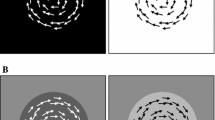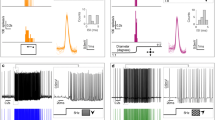Abstract
Neurons of the class described respond by a discharge with a frequency of 150–250/sec to motion of single objects in a large receptive field. The response depends directly on the size of the object. The neurons are selectively sensitive to motion of dark objects. Widening a dark border (bringing a black disc closer) evokes a stronger response than narrowing a dark border (moving a white disc further away). The response to uniform movement consists of high-frequency volleys of discharges separated by pauses. Repeated movements along the same trajectory induce habituation; after cessation of the movements sensitivity is restored with a time constant of about 30 sec. The role of lateral inhibition and local habituation in the identification of the specific features of optical stimuli is discussed.
Similar content being viewed by others
Literature cited
A. I. Gabov, "Unit responses in the pretectal zone of the fish brain," Fiziol. Zh. SSSR,58, 1462 (1972).
G. M. Zenkin and I. N. Pigarev, "Visually dependent activity in the cervical nerve chain of the dragonfly," Biofizika,16, 299 (1971).
N. B. Kostelyanets, "Investigation of off-responses of the frog retina to a change in the speed of a moving stimulus," in: Investigation of the Analysis of Information in the Visual System [in Russian], Nauka, Leningrad (1970), pp. 40–49.
N. B. Kostelyanets and E. I. Leushina, "The perception of motion," in: Physiology of the Sensory Systems. I. The Physiology of Vision [in Russian], Nauka, Leningrad (1971), pp. 304–318.
P. A. Mokrushov and L. I. Frantsevich, "Neurons sensitive to the movement of contrasting objects in larvae of the dragonfly Aeschna cyanea," Zh. Évolyuts. Biokhim. i Fiziol.,9, 189 (1973).
E. N. Sokolov, "Mechanism of memory at the neuronal level," Biol. Nauki,11, 33 (1968).
A. Ya. Supin, "Unit responses of the rabbit visual cortex to moving point stimuli," Fiziol. Zh. SSSR,58, 647 (1972).
T. Collett, "Visual neurones in the anterior optic tract of the privet hawk moth," J. Comp. Physiol.78, 396 (1972).
O.-J. Grüsser and U. Grüsser-Cornehls, "Neurophysiologie des Bewegungssehens," Ergebn. Physiol.,61, 178 (1969).
O.-J. Grüsser, D. Schaible, and J. Vierkant-Glathe, "A quantitative analysis of the spatial summation of excitation within the receptive field centers of retinal neurons," Pflüg. Arch. Ges. Physiol.,319, 101 (1970).
G. Horn and C. H. Rowell, "Medium and long-term changes in the behavior of visual neurones in the tritocerebrum of locust," J. Exp. Biol.,49, 143 (1968).
R. B. Northrop and E. F. Guignon, "Information processing in the optic lobes of the lubber grasshopper," J. Insect Physiol.,16, 691 (1970).
C. H. F. Rowell, "The orthopteran descending movement detector neurones: a characterization and review," Z. Vergl. Physiol.,73, 167 (1971).
C. H. Rowell, "Variable responsiveness of a visual interneurone in the free-moving locust and its relation to behavior and arousal," J. Exp. Biol.,55, 727 (1971).
S. L. Swihart, "Single unit activity in the visual pathway of the butterflyHeliconius erato," J. Insect Physiol.,14, 1589 (1968).
C. A. G. Wiersma, "Neuronal components of the optic nerve of the crabCarcinus maenas," Proc. Kon. Ned. Akad. Wetensch.,C73, 25 (1970).
C. A. G. Wiersma and T. Yamagushi, "Integration of visual stimuli by the crayfish central nervous system," J. Exp. Biol.,47, 409 (1967).
Additional information
Institute of Zoology, Academy of Sciences of the Ukrainian SSR, Kiev. Translated from Neirofiziologiya, Vol.6, No.1, pp.68–74, January–February, 1974.
Rights and permissions
About this article
Cite this article
Frantsevich, L.I., Mokrushov, P.A. Responses of high-frequency movement detector neurons in dragonfly larvae to motion of single objects. Neurophysiology 6, 54–59 (1974). https://doi.org/10.1007/BF01064647
Received:
Issue Date:
DOI: https://doi.org/10.1007/BF01064647




